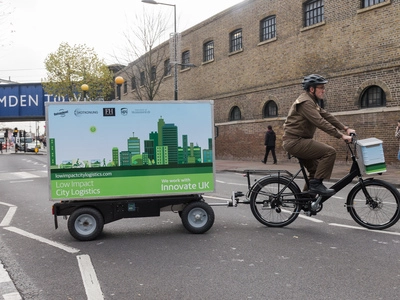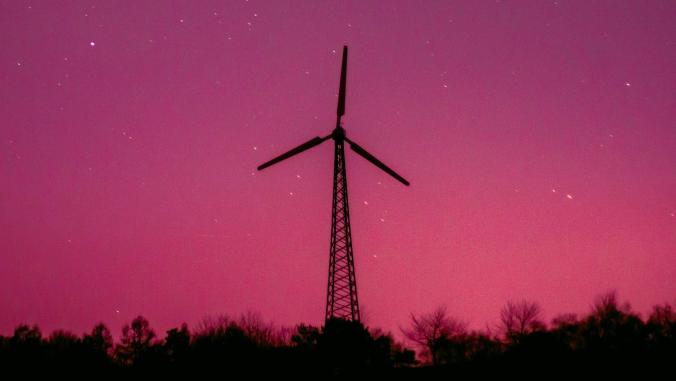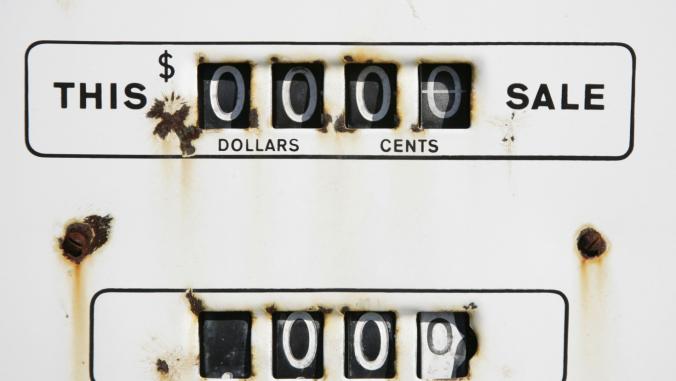Bikes, EVs and LNG trucks: How delivery giant UPS is steering 'beyond diesel'
Bikes, EVs and LNG trucks: How delivery giant UPS is steering 'beyond diesel'

Delivering on sustainable transportation?
Diesel vehicles — the scourge of air pollution campaigners everywhere — are having a torrid time. Since being championed by the U.K. government in the early noughties for its superior fuel efficiency and lower carbon emissions compared to standard petrol, fears over the fuel's impact on the air we breathe have heightened, diesel car sales dramatically have declined (aided by the occasional scandal along the way), and electric vehicle sales have surged.
But if EVs offer a cleaner, increasingly cost competitive alternative to fossil fuel passenger cars, finding a solution for large freight, on the other hand, is far more complicated. Trucks, vans and heavy goods vehicles require significant torque and range to deliver their hefty loads, which typically has ruled out pure-electric alternatives for freight.
Yet, with one of the world's biggest transportation companies looking to steer its business away from the fuel, it seems that even in the freight sector the end of the road could be in sight for diesel.
Not content with merely driving diesel vehicles out of congested cities, UPS is mapping out a journey that would see diesel removed from its ground transport business altogether, explains Peter Harris, European director for sustainability at the logistics giant.
"We have an innovation-led strategy to address the challenges of emissions and congestion," he tells BusinessGreen. "A big piece of that innovation strategy is about: How do we go beyond the diesel truck?"
For a company which delivers 20 million packages and documents each day using a 9,500-strong road fleet in Europe alone — the overwhelming majority of which run on diesel — this is no small undertaking, even if the concerted moves it has been making towards alternative, low carbon fuels and technologies in recent years have provided a strong signal to the market of things to come.
By as soon as next year, the firm is aiming for a quarter of all new vehicle purchases it makes each year to be alternative fuel or advanced technology vehicles, and by 2025 it wants 40 percent of all of its road fleets worldwide to run on low carbon or alternative fuels.We have an innovation-led strategy to address the challenges of emissions and congestion. A big piece of that innovation strategy is about: How do we go beyond the diesel truck?
"That's really going from experiment to scale, at that stage, because we have a 110,000-vehicle fleet, so we're buying thousands of vehicles every year," says Harris. "If we're talking about a quarter of those being electric vehicles, we're not messing around with small numbers anymore. It's really starting to get to the point where it's making a big difference."
Indeed, UPS has been investing in electric trucks, pedal-powered courier deliveries and low carbon fuels for several years. But as Harris explains, developing a low emission logistics operation covering both urban and long-haul journeys amid rapidly changing lifestyles and consumer demands requires far more than just investment in new technologies — it also requires deep consideration about how these technologies can work in unison with each other to deliver efficiencies, and even potentially open up new business opportunities.
"That's what it's all about — it is about joining these technologies up, not just a bit of this or that. They have to fit together in a system," he says.
Speaking to BusinessGreen earlier this month, Harris set out the three major strands to the strategy. "It's going to be quite an exciting year," he adds.
Renewable gas trucks
If a large parcel's journey to its inner-city destination begins out in the sticks, or indeed in another country altogether, it likely will need picking up alongside large quantities of other items in articulated heavy trucks and driving long-haul to a major distribution center on the outskirts of a city.
Unsurprisingly, decarbonizing these journeys remains a bit of a headache, although UPS is looking at several options to pick up these journeys in the future, including reserving more than 100 Tesla all-electric semi-trucks. However, Elon Musk's EV firm won't be putting its potentially game-changing haulage offering into production until next year, and in any case, it is unlikely to suit all applications and geographies.
In the immediate term, therefore, UPS is working to shift away from high carbon fuels, and since the turn of the year it has begun launching the first of its new generation of gas-powered HGVs in the United Kingdom, which run on low carbon "renewable" liquefied natural gas (LNG) and are similar to HGVs that were trialed by UPS during the London Olympics in 2012.UPS is working to shift away from high carbon fuels, and since the turn of the year it has begun launching the first of its new generation of gas-powered HGVs in the United Kingdom.
"These are our articulated heavy trucks that operate overnight on the motorway, and there's no possibility of electrifying them at the moment," Harris explains. "Renewable gas is where we want to go with this, as it is very low carbon footprint."
Moreover, UPS is working with Gasrec, which is supplying the fuel, to develop a new system that will ensure the LNG is renewable, Harris says, with a view to increasing its number of LNG trucks on U.K. roads.
"It's a system that is the equivalent to the way you can buy renewable energy," he explains. "So if you go to your electricity supplier and buy renewable electricity, you still get regular electricity from your plug, but you are buying a certain amount of renewable electricity generation. So we are creating that same system for renewable gas in conjunction with our provider Gasrec."

Range-extended electric vehicles
The next stage in a parcel's journey is from out-of-town delivery depots to inner city distribution centers, which potentially means driving through both urban and rural areas over distances typically beyond the range of most current battery-only vehicles.
So, following a successful trial with technology developer Tevva Motors in 2015, UPS in the coming weeks will begin permanently deploying its first range-extended electric delivery vehicles in the United Kingdom — 10 in and around Birmingham and five operating in the Southampton area.
Boasting a small, 1.6-liter diesel engine alongside a battery, these vehicles are designed to automatically switch into pure electric mode while driving in more densely urban and polluted areas. That way, zero emissions are produced in air pollution hotspots of a city, while the vehicle also has a far greater driving range — up to several hundred kilometers further — than an EV, as its diesel engine can charge up the battery while on the go. And in the future, Harris says, these small diesel engines may even switch to low carbon gas or hydrogen instead to further cut down emissions.
"The key thing we are trying to achieve is that zero emission solution in the city, and we can still do that while recognizing the fact that pure EVs have a range restriction," he explains. "So it's a bridging solution until we get to the point when pure EVs have that range, which is a little way away."
Cycles
When it comes to a parcel's final leg in dense urban centers, increasingly it makes sense to dispense with four-wheeled vehicles entirely, as most companies involved in delivery or logistics are realizing. A combination of congestion, fuel costs and growing regulatory restrictions or taxation in city centers makes smaller, pedal-powered delivery the obvious choice.
"The beauty of cycles, is that we are talking about getting rid of the trucks altogether," Harris says. "You can go so far by having trucks that are low or zero emission — that's great and a big part of our future — but there are circumstances where cities want something even beyond that. What they want is zero trucks. It is entirely feasible to conduct last-mile logistics in a really dense urban environment using cycles, and we've been doing it for several years in cities such as Hamburg, Munich and Dublin."
London, however, is far denser, trickier to navigate and has fewer places to park the bikes and logistics systems it is using in those other European cities, Harris explains. UPS is therefore developing an even smaller solution for cities such as the U.K. capital. The containers on the new power-assisted bikes are deliberately designed to be no bigger than human height so as not to intimidate other pedestrians. "If we ever get to the position where cycle logistics is frightening people, then we've lost the game. It has to blend in," Harris says. "This is about scaling the solution to suit the congested environment."It is entirely feasible to conduct last-mile logistics in a really dense urban environment using cycles, and we've been doing it for several years in cities such as Hamburg, Munich and Dublin.

In conjunction with smaller bike containers, UPS also has developed a larger transfer trailer that takes six boxes, which would be preloaded in a downtown depot before being ridden out and temporarily stationed somewhere for pick up by the smaller cycles. And, with fewer people driving and parking in London, Harris believes additional city spaces such as underground car parks could in future start freeing up and potentially become used as "consolidation logistics hubs."
"That's repurposing an under-utilized space in the city that's currently used for parking cars," he explains. "[We want to] think about a new vision for that space, with a downtown logistics hub making zero emission, zero truck cycle solutions possible."
Gas trucks, electric vehicles, hybrids, cycles and even underground car parks — it is a lengthy to-do list, but these aren't the only irons in UPS's fire. The firm also has been working on a project at its depot in Camden, where it has installed a smart grid, bolstered by energy storage systems, to enable all 170 of its delivery vehicles in London to go electric. That project officially comes to an end in September, but Harris believes it has opened up many further opportunities to explore, such as potential vehicle-to-grid revenues.
"We will have significant stored energy capability in our overnight fleet, so is there an opportunity for us to play in the V2G market?" he says. "This is a whole new area, and it is all about transportation companies like us finding ourselves in a world where they need to engage with and understand not only transportation but also energy."
All in all, from motorways, to city depots, to cycles, UPS's is a tantalizing vision for a fully low and even zero emission logistics network in the U.K. It is a direction Harris is convinced the world is moving towards, even if it remains to be determined how quickly.
"This is where the world's going," he says. "Is it all perfect? No. We've got a lot to learn. But we're really trying to give shape to that vision, and bring to the market the key technologies that need to fit together like a jigsaw."
The drive away from diesel and high carbon, polluting freight has, for UPS at least, already well and truly begun.
This story first appeared on:





